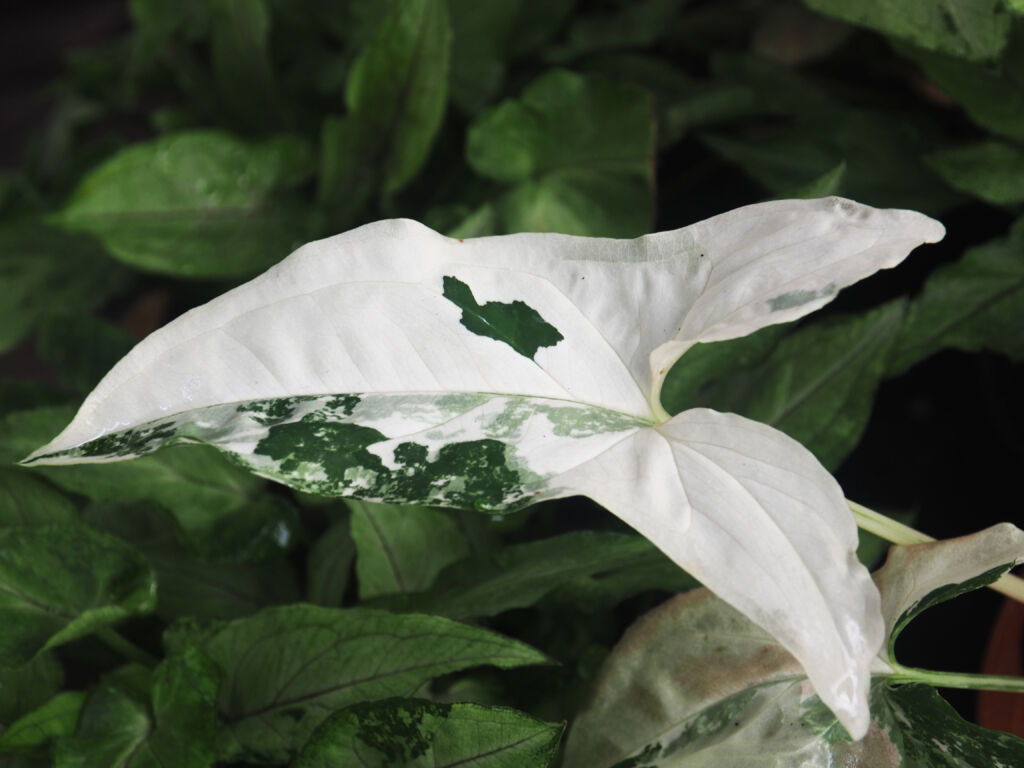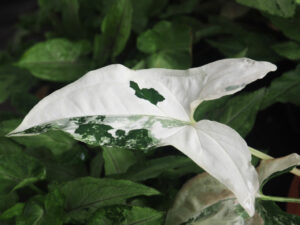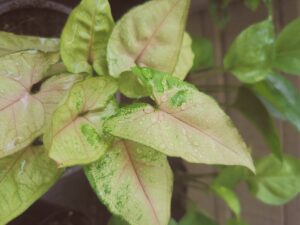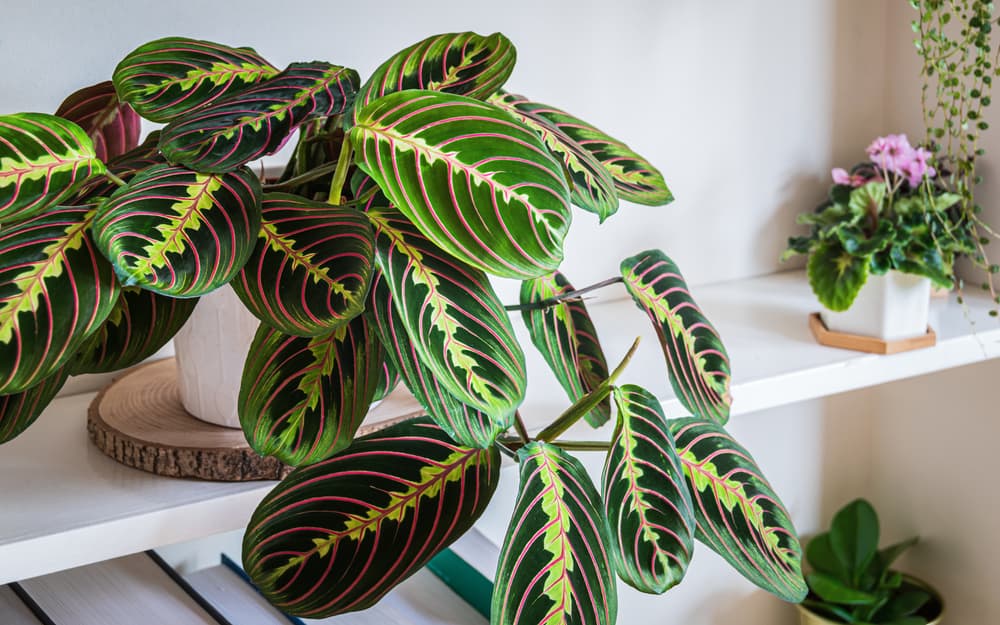HousePlantJoy is supported by our audience. When you purchase through one of our links, we may earn a small affiliate commission. As an Amazon Associate I earn from qualifying purchases. Your cost is not affected.
==================
Syngonium White Butterfly Description
The White butterfly plant, also known as Syngonium podophyllum, is a common vine houseplant. This plant has many names, such as a white butterfly, American evergreen, nephthytis, and five fingers.
But the most common of all is arrowhead vine or simply arrowhead. Its name, arrowhead, is based on its unique leaves shaped like an arrow. These leaves can grow up to seven to 14 cm long and often reaches a height of three to six feet.
The subtle color and arrowhead foliage produce a butterfly wings illusion, hence the name white butterfly arrowhead. White butterfly looks amazing when cascading, making it ideal for hanging baskets outdoors or indoors.
In the long run, the typical arrow shape will eventually become either lobe or a divided leaf. And as the plant matures, the leaves color will become more distinct. It varies depending on the plant’s age, from creamy white to bright pink and dark green.
How to Plant White Butterfly
Step 1. For starters, choose a container, either a hanging basket or a pot with a drainage hole. Alternatively, since butterfly plants love climbing, you may also consider adding a moss pole or using ties to aid your plant in climbing up.
Step 2. Then, get some healthy, high-quality potting soil. You’ll know if it is healthy soil when it’s lighter compared to common topsoil, sterile, and pest-free. It may also have a mix of mild starter fertilizers.
Step 3. Now prepare the container where you want to plant your white butterfly. Do this by filling the container with soil about 2 inches from its rim.
Step 4. After that, dig a small hole using your hand or a trowel. Make sure that the hole is small. It needs to be just enough to fit the white butterfly plant’s roots.
Step 5. Next, plant your white butterfly into the hole, cover the roots with soil, and press firmly.
Step 6. And lastly, water the plant thoroughly and place it in a location with moderate sunlight.
Note: Don’t forget to repot your plant in a new, slightly larger one every two years.
White Butterfly Plant Care
Once properly planted, the vine can be left alone and does not need excessive attention. White butterfly is popular for its versatility and low maintenance. It is also an easy-to-grow plant that can thrive even under partial shade.
But since Syngonium is a perennial plant native to the semi-tropical countries of South America, its caring should mimic these countries’ climate conditions. Here are the practical tips for caring for white butterfly plants.
Watering White Butterfly Plant
The white butterfly plant only requires watering on an occasional basis, perhaps every week or two, during the summer and less in winter. This plant prefers well-drained yet still-moist soil.
Letting the plant dry (but not completely) between waterings can help avoid the chance of root rotting. To maintain healthy foliage, mist the plant’s leaves. It is best to water the plant when the soil is dry and before the leaves begin to wilt.
Light and Humidity
Aroids plants like the white butterfly do not enjoy full sunlight. So, when choosing where to place the plant, avoid areas that are too bright. The ideal light would be a partial shade away from a South-facing window.
Humidity is vital for white butterfly plants since dry air will result in leaf crisping. To ensure an increase in humidity, try grouping plants, misting, pebble trays, or humidifiers. Also, keep the plant where the temperature stays at 61°F-70°F or does not fall below 55°F.
Soil
I recommend using soil that is well-draining and made purposely for houseplants. Like their natural habitat, white butterflies can get well-drained soils rich in organic matter. Avoid soil that is basically for growing vegetables. Instead, create a DIY potting mix.
The mixture can include a half ocean forest, a quarter coco coir, a quarter charcoal, pumice soil, and three or four handfuls of worm compost. Then apply half-strength indoor plant liquid fertilizer at least once a month. For alternatives, put slow-release fertilizer or compost in early spring.
Pruning
Pruning helps you maintain your desired size and shape for your plant. Trimming the plant’s foliage keeps your butterfly plant neat-looking. This also encourages the development of aerial roots and limits the development of stalky roots.
Pruning is essential, especially for plants that are planted in tight spaces. Furthermore, your plant can become lanky and floppy when pruning is disregarded for a long time.
Propagating
Rooted butterfly plants are ready for stem cutting and can be quickly propagated in the spring and summer months. Once you notice some aerial roots on a stem, take a section of that stem.
To increase the chance of successful replanting, place the cut-out stem in a container with water and leave it for a few weeks. Within a few weeks, a new sprout of roots will appear. After a month, these roots will strengthen, possibly topping off the water. When that happens, you can plant the cutting into the new soil.
White Butterfly Common Pests and Diseases
Butterfly plants are relatively resistant to pests of some sort. However, keeping them alongside other houseplants can invite pests like spider mites and aphids. When you encounter such a problem, treat your plant ASAP!
Bacterial root rot and bacterial leaf spots are the most common diseases of butterfly plants. These afflictions are due to over-watering, so avoid letting the plant go too wet.
Is the Syngonium White Butterfly Right for Your Home?
Did you know that the Syngonium White Butterfly can be poisonous to animals and humans? For this reason, keep the plant away from your pets and children’s reach. But even so, this plant is proven to be an effective air purifier. In order to keep your plant in the best condition, follow the practical tips on how to care for arrowhead plants.
Read More











